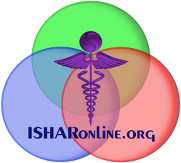NEW ISHAR FEATURE: Interactive Visual Mapping

One of the problems with any list of data is its nonholistic nature. In this instance "holistic" is meant in the very literal sense of providing a complete picture of a subject's various parts in simultaneous relation to one another, a description of the whole in addition to the parts. ISHAR is working to address this issue by creating a comprehensive visual map of Integrative Studies subjects, showing their holistic relationships with each other and with a scientific framework describing modalities, intentions and geo-cultural heritage. This interactive navigation map is the first of its kind, and ISHAR is proud to provide a new paradigm for exploring Integrative Studies.
Read on to learn how to use the ISHAR Map:
The ISHAR Map shows numerous Topics and their relationship to Classifiers, a framework of data that is used to sort, organize and connection concepts. The Classifiers on ISHAR include:
- Modality: The method in which the Topic is used. Ingesting herbs would be consider Materia Medica, a meditative practice would be Mind/Body, and acupuncture would be considered both Mind/Body and Physical Intervention.
- Intention: This describes the intended consequence of any given Topic (NOTE: Intention is not equated with efficacy). An effort to increase lifespan or quality of life in already healthy individuals is Optimization, a regimen to avoid disease would be Prevention, and treatment to heal an ill person would be Restoration.
- Geo-Cultural: The most complex of the ISHAR Classifiers, this describes the geographical and cultural roots of a given Topic. Over time some Topics evolve away from their roots to include other influences, and when possible these are reflected as additional connections. Ayurveda would be considered a Hindu/Vedic Topic, while Acupuncture is both Chinese and Western, a result of its Chinese origin combined with Western adoption and adaptations.
The ISHAR Map is made up of dozens of Topics ![]() (the concepts discussed on ISHAR) and the connections between each other or various Classifiers
(the concepts discussed on ISHAR) and the connections between each other or various Classifiers ![]() (which describe the nature of certain elements, such as modality, etc). The map is completely interactive, allowing you to grab any Topic or Classifier and move them around to explore their connections, group them into whatever design is intuitive to you, or stretch out condensed areas to illuminate connections that may have been overshadowed.
(which describe the nature of certain elements, such as modality, etc). The map is completely interactive, allowing you to grab any Topic or Classifier and move them around to explore their connections, group them into whatever design is intuitive to you, or stretch out condensed areas to illuminate connections that may have been overshadowed.

In addition, if you double click on any Topic or Classifier a window will pop up with more options. For Topics, this will include a link that will lead to the ISHAR page's discussion about that same Topic. For either Topics or Classifiers, there will be a lightning symbol ![]() which will center the map on that topic and will show only the connections that relate to that given Topic or Classifier. This allows you to explore relationships on multiples dimensions, filter content and navigate by revealed connections rather than prior knowledge.
which will center the map on that topic and will show only the connections that relate to that given Topic or Classifier. This allows you to explore relationships on multiples dimensions, filter content and navigate by revealed connections rather than prior knowledge.
This feature is just the beginning; ISHAR plans to utilize this type of nonlinear navigation to aid in new perspectives on many topics relating to Integrative Studies. Please let us know what you think of the ISHAR Map at [email protected], whether you like it, don't understand it or want to see more data on it, we want to hear from you!
